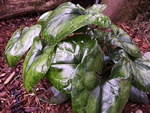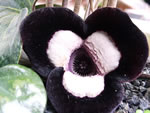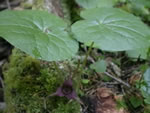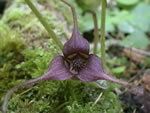How to Grow and Care for Wild Ginger Plants
Asarum species
         
Wild Gingers are low growing, woodland perennials that are known for their showy, Cyclamen-like,
heart shaped foliage and their very unique, three lobed flowers that hide from view below the foliage.
Asarum plants are generally slow to get established but once they take hold they will spread by rhizomes just below the soil surface to create a beautiful, ground covering carpet.
Most Asarum species are evergreen, but a few species like Asarum canadense are deciduous.
The common name of Wild Ginger refers to the fact that when crushed, the stems and roots have the strong aroma of lemon ginger. Asarums, however, have no relationship whatsoever to the species of plant that is used to produce culinary ginger (Zingiber officinalis).
|
 |
Wild Ginger plants are an excellent choice for the shady woodland garden or border,
and look superb when growing in containers where their flowers can be admired more easily.
Growing Requirements for Wild Ginger Plants
Wild Ginger plants should be grown in a site with light to deep shade, but they will appreciate a little morning sun. Asarums are sometimes capable live in poor, dry soil but the result will be very unsatisfactory.
For Gingers to thrive, they should be planted in moist, humus rich, slightly acidic, well-drained soil.
Add plenty of compost and fallen conifer needles (if available) to the soil at planting time.
Water regularly and thoroughly to keep the soil evenly moist, especially if growing Wild Ginger in planters.
The only feeding that your Wild Ginger will need is an annual top-dressing of compost in the spring. |
Take precautions to protect your Wild Gingers from ravenous attacks by slugs and snails,
especially in the spring when new growth is emerging.
Panda Face Ginger, Asarum maximum |
Panda Face Ginger is a fairly rare, clump forming species from China that grows to about 6" tall and a foot wide. Their shiny, heart shaped, 3" leaves are dark green with silvery-green marbling.
The velvety, 2"-2½" flowers of the Panda Face are fleshy, white trumpets bordered with a wide band of dark purple or black, and often remain un-noticed as they peak out from beneath the foliage, unless you are willing to get down on your knees. Panda Face Ginger is an awesome addition to any shade garden.
Asarum maximum is hardy in USDA zones 7-9. |
  |
Long-tailed Ginger, Asarum caudatum |
  |
Long-tailed Ginger are easy to grow plants that are native to the coastal forests and mountains of western North America. They are 12" tall, mat forming plants that spread up to 3 feet by rhizomes and trailing stems, producing two long stemmed, kidney shaped, finely haired, 4"-6" wide leaves at each node. In early April, Long-tailed Gingers begin to produce their fuzzy, long tailed, 3 rayed, maroon flowers that only remain visible until May, when the new foliage outgrows the flower stems. Western Wild Ginger are hardy in USDA zones 6-9.
|
|





